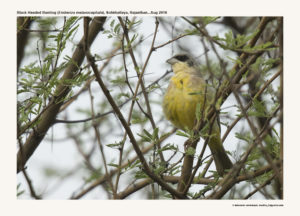
Black Headed Bunting Emberiza melanocephala
Etymology:
- Emberiza : Old German name Embritz for a bunting
- Melanocephala : Greek word Melano – black ; kephalos –headed { Black headed}
Vernacular Names : Baluchistan: Zarden drushk, Sind: Booree, Hindi: Gandam, Pun: Kala sir boli,
Guj: Kala mathano gandam, Shyam shir gandam, Te: Nalla tala jinuwayi, Mar: Kalya Dokyacha Bharit
Distribution in India: Winter Visitor in West India
Description: Size of 16-18 cm. The breeding male has bright yellow underparts, chestnut upperparts
and a black hood. The female is a washed-out version of the male, with paler underparts, a grey-
brown back and a greyish head. The vent is yellow.
Habitat: It is found in open areas with dispersed trees, shrubs and hedges, often near fields of cereal
crops.
Food Habits: They feed on Seeds and Grains. They are usually seen in large flocks forging on the
ground for seeds and grains. They eat insects during the breeding season
Breeding Habits: They breed in summer, building a nest in a low bush or on the ground. The nest is a
cup made of dry grass and lined with hair. The clutch consists of four to six eggs. The eggs hatch
after about 13 days and the chicks fledge after about 10 days. Its natural food consists of insects
when feeding young for easier digestion for chicks and water content in the worms supply the chicks
with their water requirements. Also the protein helps them grow faster.